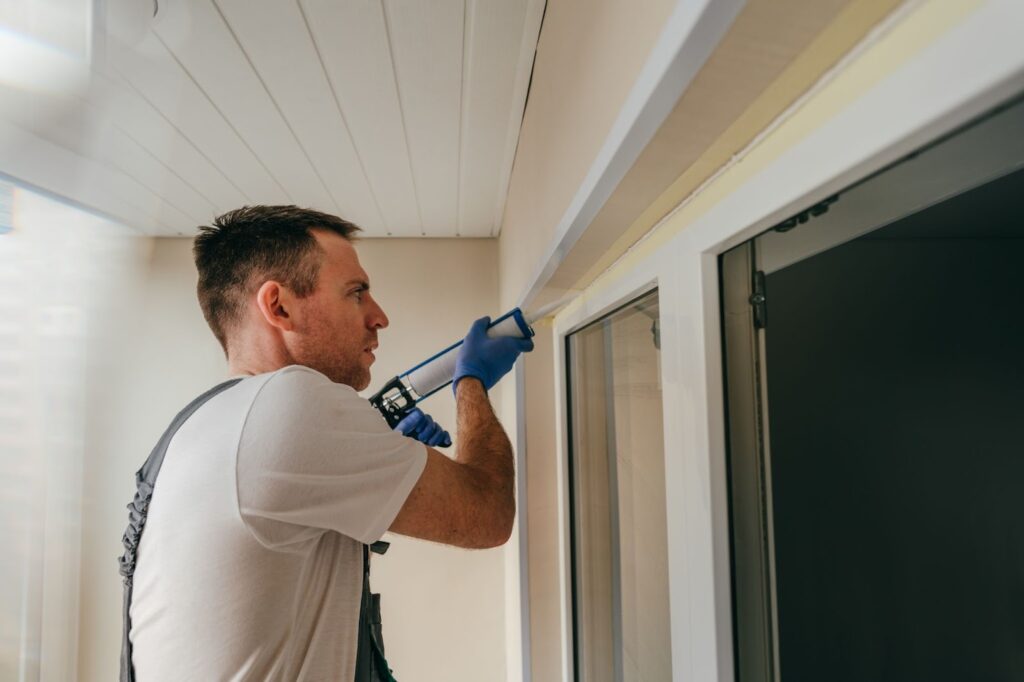Every homeowner knows the frustration of seeing small cracks around windows, doors, or tubs. These tiny gaps may seem harmless, but they can cause significant issues like moisture buildup, air leaks, and higher energy bills. Over time, these problems reduce comfort and damage your home’s structure. Caulking provides a simple yet powerful way to seal those weak points, protecting your home and keeping it efficient year-round.
Understanding Caulking in Home Maintenance
Caulking is sealing joints, seams, or cracks to block air, water, and insects from entering. It’s typically applied where two surfaces meet, like between walls and trim or around windows. When properly used, it prevents damage and maintains a home’s energy efficiency. Additionally, it helps preserve a home’s interior appearance by keeping surfaces clean and smooth.
The Purpose of Caulking in Everyday Homes
Caulking serves as a home’s invisible barrier against outside elements. It prevents moisture from soaking into walls and foundations, reducing the risk of mold or rot. Similarly, it blocks drafts that cause energy loss during hot or cold seasons, keeping your home’s temperature stable and lowering utility costs. Caulking also reduces dust, allergens, and pests, improving indoor air quality and comfort.
Common Types of Caulking for Different Uses
The most common home caulking materials are silicone, acrylic latex, polyurethane, and butyl rubber. Silicone is best for bathrooms and kitchens because it resists water and remains flexible. Acrylic latex caulk works well indoors, especially around baseboards and trim, since it’s paintable and easy to clean. Polyurethane is strong and ideal for outdoor joints exposed to sunlight or rain. Butyl rubber caulk suits roofing and gutters, as it adheres well to metal and concrete surfaces.
How Caulking Enhances a Home’s Appearance
Caulking protects and beautifies your home. It hides gaps, creates clean lines, and gives finished edges a professional look. Fresh caulk around tiles and fixtures in kitchens and bathrooms makes everything appear polished. Similarly, well-sealed trim or crown molding looks more refined and complete. Keeping caulking in good shape enhances your home’s aesthetic and adds value.
Why Caulking is Essential for Every Home
Every house is exposed to changing weather, humidity, and time-related wear. Without caulking, small gaps widen, letting in moisture and air that leads to costly repairs. Sealing these spaces improves insulation, extends material life, and strengthens your home’s defenses. Additionally, it boosts comfort, cleanliness, and energy performance with minimal effort.
Energy Efficiency and Lower Utility Costs
Proper caulking directly improves energy efficiency by keeping indoor air from escaping. When doors and windows leak air, your HVAC system works harder to maintain the temperature. Sealing those leaks can reduce energy use by as much as 20 percent, based on 2024 energy efficiency data. This technique lowers bills and reduces strain on heating and cooling systems. Over time, well-applied caulking helps create a more sustainable and budget-friendly home.
Preventing Water Damage and Mold Growth
Unsealed joints allow water to seep into walls, floors, and other surfaces. That trapped moisture leads to rot, mildew, and mold, damaging wood and drywall. Caulking creates a tight waterproof barrier that keeps these problems from forming. Additionally, it stops water from freezing and expanding inside cracks during winter. Keeping your home sealed protects your investment and reduces long-term maintenance costs.
Improving Indoor Air Quality and Comfort
Cracks and gaps can let dust, allergens, and pollutants enter your living space. Caulking prevents these irritants from spreading throughout your home. It also minimizes outdoor noise, providing a quieter, more peaceful atmosphere. Additionally, sealing gaps helps regulate indoor temperature by blocking unwanted airflow. A properly caulked home feels cleaner, fresher, and more balanced year-round.

Key Areas in a Home That Need Caulking
Certain spots in every home are more prone to cracking and separation. Regularly inspecting and resealing these areas prevents future damage. Standard zones include bathrooms, kitchens, windows, and exteriors exposed to sunlight and moisture. Properly sealing these areas preserves both comfort and durability.
Interior Spaces That Need Caulking
Caulking is most useful around sinks, bathtubs, and backsplashes in your home. These areas are constantly exposed to moisture, making them vulnerable to mold or leaks. Similarly, sealing gaps around baseboards, trim, and vents prevents dust and air infiltration. Applying fresh caulk refreshes the room’s aesthetics by creating smooth surface transitions. Regular interior caulking maintenance helps sustain cleanliness and prevents hidden water damage.
Exterior Applications for Weather Resistance
Outdoor caulking shields your home from weather extremes. It’s most needed around windows, doors, siding seams, and roofing joints. Without it, water can seep behind walls or under siding, leading to deterioration. Similarly, sealing outdoor joints prevents cold drafts from entering during the winter months. Weather-resistant caulking provides long-term defense against both moisture and temperature shifts.
Windows and Doors as High-Priority Areas
Windows and doors are frequent culprits for heat loss and drafts. Over time, caulk in these areas can dry, crack, or pull away from surfaces. Reapplying high-quality sealant prevents air leaks and condensation buildup. This re-application improves temperature regulation and prevents paint from peeling around frames. Consistent window and door caulking ensures greater energy efficiency and visual appeal.
How to Correctly Apply Caulking for Lasting Results
Proper caulking application ensures a durable, even finish that lasts. Preparation is crucial since caulk adheres best to clean, dry surfaces. Using the right materials and techniques helps create a strong, flexible seal. Additionally, careful application enhances both function and appearance.
Essential Tools and Materials for Caulking
A caulk gun, utility knife, painter’s tape, and cleaning rag are fundamental tools for this job. The choice of caulk—silicone, latex, or polyurethane—depends on the surface type and location. Painter’s tape ensures straight lines and neat edges during application. Keeping a damp cloth nearby allows quick cleanup of excess caulk. A smoother tool or your fingertip helps create a clean, uniform bead.
Step-By-Step Process of Applying Caulk
Start by removing any old caulk and cleaning the area thoroughly. Make sure the surface is dry before applying the new sealant. Cut the caulk tube tip at a 45-degree angle and apply a steady bead along the joint. Use even pressure on the caulk gun to maintain consistency. Smooth the bead with a caulk finishing tool and remove any tape before the caulk sets. Allow it to dry according to the product’s recommended curing time for best results.
Common Caulking Mistakes to Avoid
Skipping surface preparation is the most common error that leads to poor adhesion; applying too thick or too thin a bead results in uneven sealing. Choosing the wrong type of caulk for specific materials can also shorten its lifespan. Additionally, some homeowners expose new caulk to water before it cures, weakening the seal. Avoiding these mistakes helps extend the life and effectiveness of your caulking work.

Maintaining and Re-Caulking for Long-Term Protection
Caulking needs maintenance as materials age and environmental conditions change. Regular inspection ensures gaps remain sealed and protective. Cracked, discolored, or peeling caulk indicates the need for re-application. Keeping up with these repairs extends your home’s life and prevents larger damage.
Signs That Your Home Needs Re-Caulking
You can often spot caulking issues through visible cracks or peeling edges. Drafts near windows or damp spots on walls are also warning signs. Old, brittle caulk loses flexibility and may pull away from the surface. When this happens, it no longer protects against water or air leaks. Re-caulking renews your home’s defense and keeps interiors in top condition.
Routine Seasonal Inspections
Inspecting caulking twice a year helps catch problems before they worsen. Seasonal changes cause materials to expand and contract, straining old seals. Focus on high-moisture areas like kitchens, bathrooms, and exterior joints. Pay attention to corners, vents, and edges most exposed to sunlight or rain. Scheduling inspections during mild seasons allows for smoother, more effective repairs.
When to Hire Professional Caulking Services
Hiring a professional may be the best choice for large surfaces or exterior walls. Professionals use high-quality products and have the expertise to handle complex sealing projects. They also check for hidden issues such as water infiltration or structural cracks. Additionally, they can color-match caulk for a seamless, polished finish. Their precision ensures longer-lasting results and better performance overall.
Expert Answers to Common Caulking Questions
Homeowners often wonder how long caulking lasts or when to replace it. Understanding these details helps you maintain efficiency and avoid costly repairs. With precise knowledge, you can keep your home properly sealed and safe. These frequently asked questions provide helpful insights based on real-world experience.
How Long Does Quality Caulking Last?
Depending on type and exposure, caulking can last between five and ten years. Interior caulk, protected from weather, typically endures longer. Exterior caulk, constantly exposed to the sun and rain, may need more frequent replacement. Regular inspection every few years ensures continued effectiveness. Consistent upkeep preserves your home’s protection and energy efficiency.
Can You Apply New Caulk Over Old Layers?
While tempting, applying new caulk over old material often leads to failure. The old layer prevents proper bonding and may hide underlying damage. Obliterating the previous caulk provides a clean surface for a new application, ensuring better adhesion and appearance—investing time in preparation results in a longer-lasting seal.
Ideal Temperature for Caulking Application
Caulking should be done in moderate conditions between 40°F and 80°F. Applying it in extreme heat or cold affects how it adheres and cures. Similarly, humidity can cause bubbling or uneven drying. Dry surfaces provide the best base for strong adhesion. Working during mild weather ensures durable, professional-looking results.
Preserve Your Home’s Strength Through Reliable Caulking
A well-sealed home stands the test of time, weather, and wear. Reliable caulking guards every seam and surface, preventing moisture, drafts, and decay. It’s more than maintenance; it’s a smart way to protect comfort, energy, and value. Trust skilled caulking to preserve your home’s strength and keep it performing at its best for years.
Visit the JM Caulking & Construction Services LLC blog to learn how wise caulking and maintenance choices can protect your home year after year.




